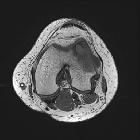differential diagnosis of high attenuating lymphadenopathy

High attenuation lymphadenopathy (or adenopathy) variably refers to abnormal lymph nodes with attenuation on CT usually higher compared to muscle, either on a noncontrast exam or following contrast administration (i.e., hyperenhancement) .
High attenuation nodes may be due to calcifications or other inorganic material:
- granulomatous infection (common)
- sarcoidosis
- amyloidosis
- treated lymphoma
- Castleman disease
- inhalational lung disease
- Rosai-Dorfmann disease
- metastases, with or without prior treatment
- papillary thyroid carcinoma (most common cause in the neck)
- bronchogenic carcinoma
- breast cancer
- mucinous ovarian carcinoma
- mucinous colonic carcinoma
- osteosarcoma
- gold salts (treatment for rheumatoid arthritis)
Hypervascular metastatic and lymphoproliferative disorders can cause high attenuation lymphadenopathy due to intranodal hemorrhage (on unenhanced CT) or hyperenhancement (on contrast-enhanced CT):
- Kaposi sarcoma
- papillary thyroid carcinoma
- Castleman disease
- Kikuchi-Fujimoto disease
- Kimura disease
- angioimmunoblastic T cell lymphoma
- neuroendocrine tumors
- renal cell carcinoma
Rarely, high attenuation lymphadenopathy has been described due to keratinization of metastatic squamous cell carcinoma of the head and neck .
See also
- lymphadenopathy
- calcified cervical lymphadenopathy (differential)
- calcified mediastinal lymph nodes (differential)
Siehe auch:
- Tuberkulose
- Sarkoidose
- Silikose
- Karzinoid
- Amyloidose
- Morbus Castleman
- papilläres Schilddrüsenkarzinom
- Rosai-Dorfman-Erkrankung
- Lymphadenopathie
- Kimura disease
- Kaposisarkom
- Histoplasmose
- hypervaskularisierte Lymphknoten
- coal workers pneumoconiosis (CWP)
- Neoplasien der Mamma
- low attenuating lymphadenopathy
- Goldtherapie
- Lymphknotenmetastasen
- sinus histiocytosis
- Lymphom (therapiert)
und weiter:

 Assoziationen und Differentialdiagnosen zu hyperdenser Lymphknoten:
Assoziationen und Differentialdiagnosen zu hyperdenser Lymphknoten:











